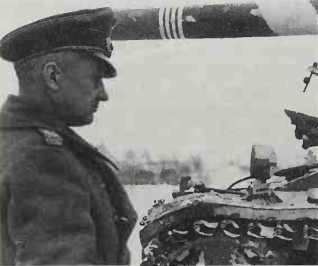The Naval Academy in 1910. Mits-cher was one of the pre-eminent carrier admirals of World War II. Flying his flag in uss Hornet, he commanded task groups in the Doolittle raid on Tokyo, April 1942, and at Midway, June 1942. As Air Commander, Solomons, his successes included direction of the operations resulting in the aerial “ambush” of Adm Yamamoto, April 18 1943. In January 1944 he took command of Carrier Division 3 which, as 1st Carrier Task Force and then Task Force 58, he headed until July 1945.
As commander of the major carrier force, Mitscher ideally complemented Adm Spruance, c-in-c Fifth Fleet, who relied heavily on his advice in all air operations. Although lacking Spruance’s depth of intellect, Mitscher leavened his senior’s instinctive caution with an intuitive tactical sense based on his vast experience in and knowledge of naval air power. Their partnership proved superbly effective in the battles of the Philippine Sea, Leyte Gulf and Okinawa; Mitscher’s contribution was also vital to success in the Marshall Islands, Hollandia, Truk and Iwo Jima campaigns. Deputy Chief of Naval Operations, July 1945—March 1946, Mitscher refused appointment as Chief in order to return to sea in command of Eighth Fleet. He died as c-in-c, Atlantic Fleet, February 1947. RO’N.
Mitsubishi A6M2 Reisen (Zero Fighter), “Zeke” (Japanese, WWII). Single-seat shipboard fighter. Prototype flew April 1
1939. Designed to have two 20mm cannon and two machine guns, the A6M2 had a powerful impact when it first fought Allied aircraft 194142. Centre-float seaplane version (A6M2-N) also built; later, more-powerful sub-types of the basic design followed. Production, over 11,280 Reisen (all types). One 950hp Nakajima NKIC Sakae 12 engine; max. speed 332mph (534kph); two 20mm cannon, two 7.7mm machine guns, 2641b (120kg) bombs.
Mitsubishi G4M1/2, 1-Rikko, “Betty” (Japanese, WWII). Long-range medium bomber; crew 7. Prototype flew October 23 1938; first production aircraft completed
April 1940; by December 7 1941 about 150 on Japanese Navy’s strength. With progressive modifications and improvements served in bomber units until 1945; a good aircraft, but vulnerable to fighter attack. Production, 2,446. Two l,825hp Mitsubishi MK4T Kasei engines; max. speed 272mph (438kph) one 1,7641b (800kg) torpedo or up to 2,2051b (1,000kg) bombs, one 20mm cannon and four 7.7mm machine guns.
MLRS (Multiple Launch Rocket System). An American battlefield support system: a tracked launcher for 12 X 227mm rockets with a range of 19 miles (32km). Each rocket carries 644 0.51b (0.225kg) shaped charge/fragmentation dual-purpose sub-munitions. A production line in Europe will supply the British, French, Italian and West German armies. The Germans are developing a minelaying rocket for mlrs that will allow a vehicle to lay 336 antitank mines in an area of 2 sq miles (5 sq km) in one minute at a range of 24 miles (40km) and an international consortium is developing a
27-mile (45km) range rocket with radar homing anti-tank submunitions. The Americans are also developing a 144-mile (240km) range ballistic missile, atacms (Army Tactical Missile), which can be substituted for six of the smaller rockets on the launcher. EJG.

Model on the Eastern Front
Model, Field Marshal Walther
(1891-1945). Ger. Served during World War I on the Western Front and on the General Staff. A staff officer early in World War II; not until the invasion of the Soviet Union was he fully able to display his talents as a brave, energetic and tactically astute commander.
Leading 3rd Panzer Division to major successes at Bialystok, Minsk, Smolensk and Kiev. This resulted in a meteoric rise to command of the Ninth Army in January 1942. A loyal servant of Hitler, Model was nevertheless prepared to back his own judgement against the Fiihrers interference. Unusually, this attitude was respected, especially as he continued to achieve success early in 1942 with the Battle of Rzhev. His failure in Operation “Citadel”, the German offensive at Kursk, summer 1943, was to a great extent offset by the need for his defensive qualities in meeting the Soviet counterattack.
In January 1944 Model was appointed c-in-c Army Group North to check the seemingly inexorable advance of the Red Army and instituted a policy of Schild and Schwert “Shield and Sword”, consisting of systematic withdrawal followed by counterattack. His reputation as a troubleshooter earned him the nickname of “The Fiihrer’s Fireman”, and by the end of June he had been given command of Army Groups South and Centre. Having stabilized the Eastern Front, albeit on the East Prussian border. Model was next sent to France. As c-in-c of Army Group B and OB West, Model could do little but try to extricate his troops; in September he was replaced as OB West by von Rund-stedt. Model achieved one more victory against the Allied airborne forces at Arnhem, but his participation in the Ardennes offensive of December 1944 and the defence of the Ruhr in the spring of 1945 were, by his standards, failures. Finally, with defeat inevitable. Model committed suicide on April 21 1945. MS.
Moehne Dam see dams raid.
Molders, Col Werner (1913-41). Ger. Top-scoring fighter pilot of the Condor Legion in Spanish Civil War (14 “kills”), Molders was instrumental in the Luftwaffe’s adoption of the Schwarm tactical formation - four fighters in close (c200yd/180m apart) line abreast - adopted by the raf as the “Finger Four”. He commanded Jagdges-chwader 51 in France, 1940 (c20 “kills”) and the Battle of Britain (c20 “kills”).




 World History
World History









